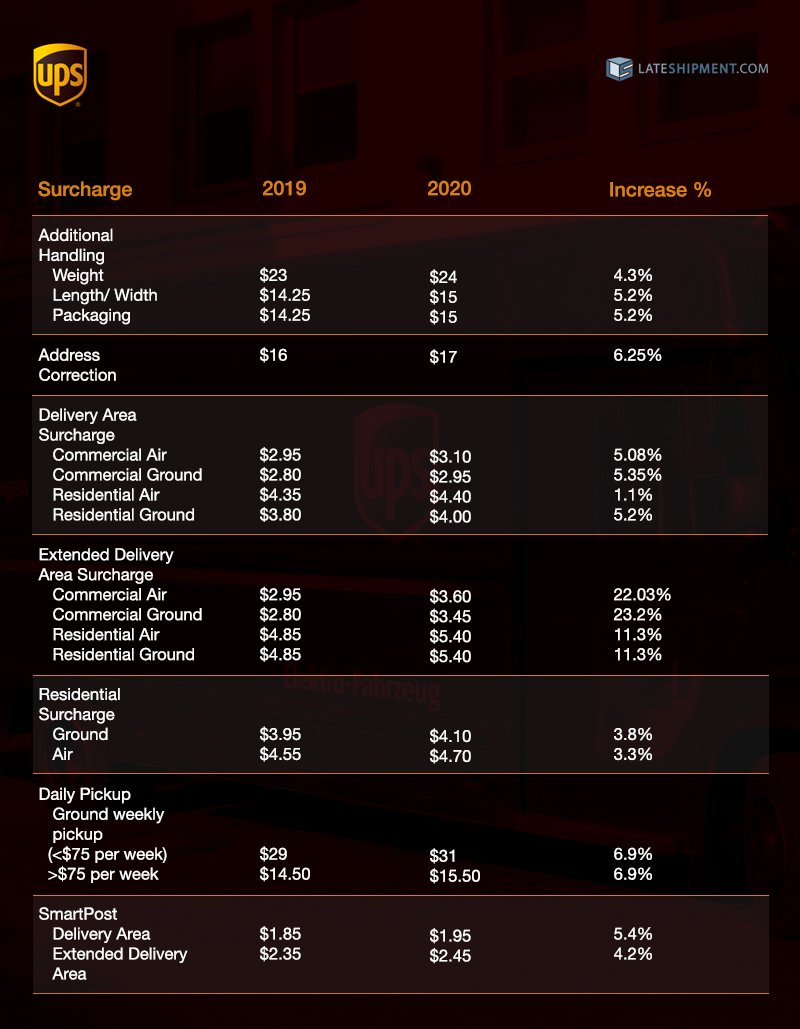Every year, shipping carriers increase the rates for their services, hitting retailers below the belt, as if the damage they do during the holiday season weren’t enough.
This year, there have been identical rate increases across both carriers on multiple services.
FedEx has announced its General Rate Increase (GRI), which will be effective from January 6, 2020, with an average increase of 4.9% on Express shipments and 5.9% on FedEx Freight.
UPS, on the other hand, will increase the rates of its services an average of 4.9% effective from December 29.
However, one can see an increase of more than 11% in certain cases.
Being aware of shipping rates can help you plan out your shipping strategy in advance and put you ahead in your last-mile game.
That might seem a challenge, but worry not! In order to save you time, we’ve charted out the data for you!
Some of the highlights from the upcoming price changes
FedEx has increased the rates of its International Premium®, Express, Ground Multiweight®, Freight, and SmartPost services.
In addition to the mentioned services, it has also increased its additional surcharges in the following ways:
- A rise of 25% on Extended Service Area Delivery from $140 per shipment to $175.
- An increase of $200 on Ground Unauthorized Packages from $675 per package to $875.
- Their surcharges for weight will apply on FedEx Express® and FedEx Ground® U.S. domestic packages if a package has an actual weight greater than 50 lbs, which was earlier applicable only for shipments with a weight greater than 70 lbs.
- Surcharges applying to any freight handling unit that measures greater than 70 inches along its longest side will now be applied to unit measures greater than 62 inches along its longest side.
UPS, on the other hand, has made the following changes:
- A rebill fee for each request to change the billing account for a shipment.
- A prohibited Item fee for packages containing prohibited articles or restricted articles not in compliance with all UPS policies & procedures and applicable laws & regulations if found in the UPS system.
- Value-added services and other charges will apply to undeliverable packages returned to the shipper. A late payment fee will be applied if an invoice is not paid in full by the invoice due date.
- The weight threshold for applying an Additional Handling surcharge will be lowered from 70 pounds to 50 pounds actual weight for UPS Ground and UPS Air services.


Impact of these rates on retailers
Despite being aware of these shipping rates and taking effective measures, there is still a worry for retailers as these rates tend to add up.
Retailers who routinely ship large packages, use long-zone express, three-day express, or ship to remote areas are likely to be subjected to an increase much larger than the stated 4.9%.
They will need to face the list of multiple, additional surcharges that make their way into their shipping bills.
With retailers barely escaping getting caught in the holiday last mile, all these increased rates from the start of the new year will be their next challenge.
After all, this is just because of carriers looking to make their last-mile delivery processes more profitable.
How businesses can reduce their shipping expenditure and minimize the damage incurred
Here are a few ways to minimize the impact of the price hike on your business.
- Stick to freight if you’re shipping oversized packages more than regular-sized ones. Anything that requires additional handling will put a dent in your pocket for sure otherwise.
- Generate shipping labels online. There are sites like Shopify that give you great discounts. As of this year, printing a return label will be twice as expensive.
- The larger your box, the more you pay, regardless of the size of the item inside. Even odd-sized objects won’t cost you additional handling charges if you package them right. You can read more on packaging odd-shaped objects here.
- Analyze your carrier’s performance and get insights on performance lapses such as delays or lost parcels. This will put you in control of shipping rates and help you negotiate for better rates.
- You can also take note of data-rich shipping reports and conclude which carrier works best for which type of delivery / destination / cost / customer / product.
- If you ship in significant volumes, sign up with multiple carriers. Carriers tend to offer better discounts during such situations to ensure a shipper stays on.
- Claim refunds for all the eligible service failures. There are over 50 of them that can get you a refund!
Check out other ways to reduce shipping costs here.
Conclusion
With these rates coming into effect right after the surcharges in the holiday season end, it is clear that shipping is not going to get any cheaper and will require a proper strategy, like while playing a game of chess or minesweeper.
While having a better understanding of these rates and shipping contracts with carriers is necessary, making use of technology that keeps you in control of your last mile and ensures that carriers always keep their word can help you ace your shipping game.
A Little about LateShipment.com
LateShipment.com is the world’s only logistics cloud tool that helps businesses of every size reduce shipping costs by up to 20% and provide memorable delivery experiences to customers at scale.
- Save up to 20% on Shipping – Automatically audit your shipping carriers’ invoices and recover refunds for 50+ service failures & billing errors including late deliveries.
- Real-Time Visibility – Monitor your outbound & inbound shipments across multiple shipping carriers on a centralized window, in real-time.
- Critical Delivery Alerts – Pay attention to daily deliveries with predictive delay alerts and more on a purpose-built dashboard for support reps.
- Proactive Issue Resolution – Proactively communicate with customers to prevent them from having bad experiences due to delivery failures.
- Custom Delivery Notifications – Send custom or automated delivery status notifications for events like “shipped,” “attempted,” & “delivered.”
- Branded Tracking Pages – Build fully-customizable order tracking pages for your customers to improve brand recall and sales.
You can start using these features in less than 2 minutes without the need for any IT/business process change or coding. And the best thing is that LateShipment.com is a simple cloud-based plug-and-play solution that can seamlessly integrate with the tools you already use.
The value we add to businesses is most evident when experienced first-hand.
It’s that simple!
Click here to start saving money on your shipping and provide outstanding post-purchase experiences.



